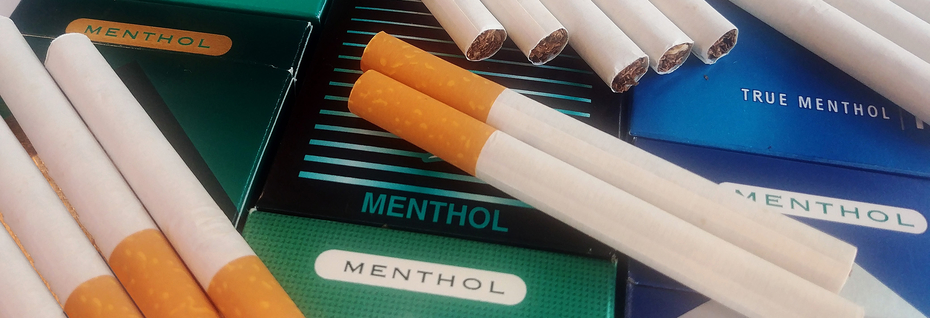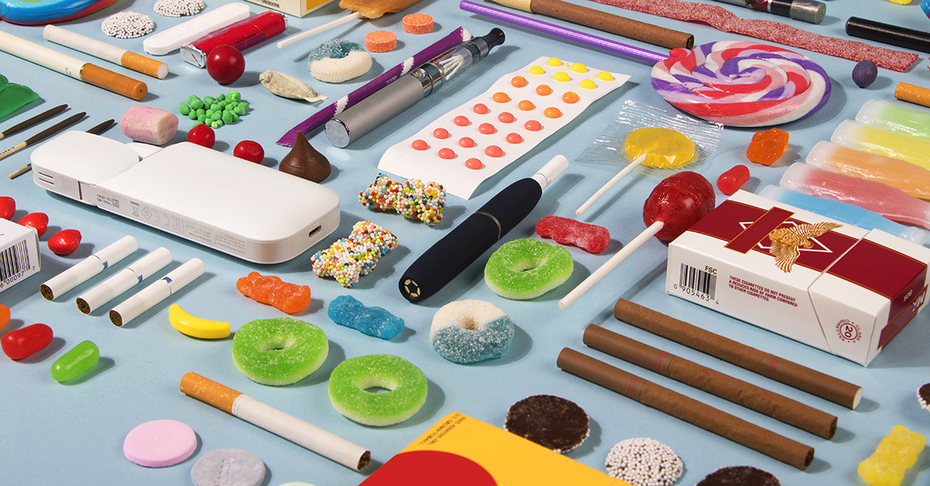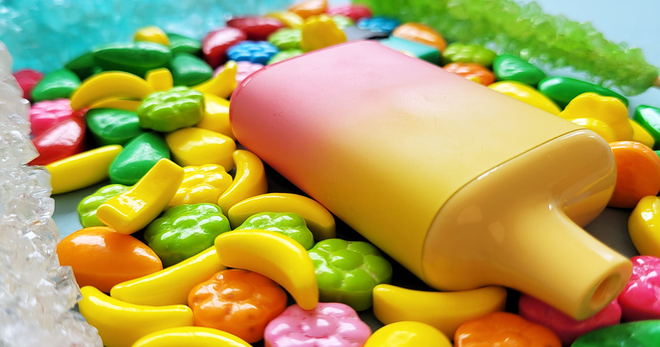Flavored tobacco use among youth and young adults
It is well established that flavors play a significant role in enticing youth and young adults to try and use tobacco products.
Federal law bans flavors in cigarettes — excluding menthol — and currently the U.S. Food and Drug Administration (FDA) prioritizes enforcement against non-menthol flavors in cartridge-based e-cigarettes, but not in other tobacco products, such as open system e-cigarettes, disposable e-cigarettes, smokeless tobacco, cigars, and hookah. These products come in an array of candy, fruit, dessert and cocktail flavors, such as sour apple, cherry, grape, chocolate, strawberry margarita, appletini, pina colada, cotton candy and cinnamon roll. Flavored tobacco products also typically have bright, colorful packages and are often sold individually and cheaply, making them even more appealing to youth and young adults. In April 2021, the administration and FDA announced they will begin the process within the year for rulemaking to prohibit the sale of menthol cigarettes and all flavored cigars. To date, FDA has not issued any proposed rules.
Research on national use patterns, perceptions, marketing and existing policies makes clear that the United States must ban all flavored tobacco products to protect public health and keep tobacco products out of the hands of young people.
Flavored Tobacco Product Use
Youth and young adults use flavored tobacco products more than other age groups. Additionally, flavored products are often the first tobacco products youth and young adults ever use.
YOUTH
- In 2019, an estimated 4.31 million middle and high school students in the U.S. used a flavored tobacco product in the past 30 days.
- 13.8% of middle and high school students used flavored e-cigarettes in the past 30 days.
- 2.0% smoked menthol cigarettes
- 2.2% smoked flavored cigars
- 1.7% used smokeless tobacco
- 0.8% used flavored hookah
- 0.3% smoked flavored pipe tobacco
- In 2019, nearly 7 out of 10 youth who were current tobacco users reported they used a flavored tobacco product. Among students who reported they were currently using a tobacco product, 72.8% of high school students and 59.6% of middle school students reported using flavored products, including:
- 68.8% of current e-cigarette users,
- 46.7% of current cigarette smokers,
- 41.9% of current cigar smokers,
- 48.0% of current smokeless tobacco users,
- 31.2% of current hookah users, and
- 31.4% of pipe tobacco users.
- In 2020, an estimated 2.93 million middle and high school students in the U.S. used flavored e-cigarettes within the past 30 days. From 2019 to 2020, the proportion of current e-cigarette users using flavored e-cigarettes increased from 68.8% to 82.9%.
- In 2020, among high school students who currently use any type of flavored e-cigarette, the most commonly used flavor types were:
- Fruit (73.1%),
- Mint (55.8%),
- Menthol (37.0%), and
- Candy, desserts, or other sweets (36.4%).
- In 2019, the year for which we have the most recent data, flavored tobacco product use was highest among non-Hispanic white youth (76.8%), compared with students of other non-Hispanic races (68.1%), Hispanics (63.1%), and non- Hispanic blacks (48.0%), though there is variability among type of tobacco product.
- Nearly 81% of youth ages 12 to 17 who had ever used a tobacco product reported that the first product they used was flavored, including:
- 88.7% of ever hookah users,
- 81.2% of ever snus pouch users,
- 81.0% of ever e-cigarette users,
- 68.9% of ever smokeless tobacco users,
- 65.4% of ever users of any cigar type, and
- 50.1% of ever cigarette smokers.
YOUNG ADULTS
- More than four out of five young adults ages 18 to 24 who have ever used tobacco reported that their first product was flavored.
- Flavored tobacco product use is higher in younger adults than in older adults. Nearly three-quarters — 72.7% — of young adult current tobacco users report flavored tobacco use, compared to just 28.6% of adults over 65.
- Among young adult non-cigarette tobacco users, 83.5% report that they use a flavored product. Hookah users reported the most flavored product use — with nearly 86% — followed closely by e-cigarette users with 85.2%.
YOUTH AND YOUNG ADULT PERCEPTIONS OF FLAVORED PRODUCTS
Research shows that youth highly prefer sweet tastes and sweet odors, which may explain the appeal of flavored products, especially the most preferred flavor categories of fruit and candy. Youth and young adults perceive flavored tobacco products as more appealing, better tasting and less harmful than non-flavored tobacco products. Flavors, especially sweet and fruit flavors, play a role in influencing tobacco use or experimentation in youth and young adults. For example, a 2016 study using a national sample of youth 13 to 17 years old found that they were more likely to try menthol-, candy- or fruit-flavored e-cigarettes if a friend offered, compared to tobacco- and alcohol-flavored e-cigarettes. Youth also perceived fruit-flavored and menthol-flavored e-cigarettes as less harmful than tobacco-flavored e-cigarettes.
Flavors, especially sweet and fruit flavors, play a role in influencing tobacco use or experimentation in youth and young adults. For example, a 2016 study using a national sample of youth 13 to17 years old found that they were more likely to try menthol-, candy- or fruit-flavored e-cigarettes if a friend offered, compared to tobacco- and alcohol-flavored e-cigarettes. Youth also perceived fruit-flavored and menthol-flavored e-cigarettes as less harmful than tobacco-flavored e-cigarettes.
All e-cigarettes have a characterizing flavor, such as tobacco, menthol, fruit or candy. A 2017 study found 15,586 distinct e-cigarette flavors on the market. Additional evidence indicates that people view flavors as an attractive characteristic of e-cigarettes, and youth and young adults cite flavors as a reason for e-cigarette use.
Youth who regularly use tobacco also report that flavoring is a leading reason for using a range of tobacco products. Among youth, non-cigarette users who had used a product in the last 30 days, a large majority cited flavoring as a primary reason they used the products.
Many hookah companies offer multiple flavors in their product lineup, which may entice hookah use among young people. A focus group of young adult hookah smokers showed that participants found the wide variety of hookah flavors appealing and liked that they could personalize their smoking experience by mixing and customizing flavors. Additionally, young adults perceive hookah as less harmful and less addictive than cigarettes.
Youth also may perceive cigars more favorably than cigarettes and consider cigars more natural, less harmful, cheaper and better smelling. The use of flavors in cigar products, including little cigars and cigarillos, may play a role in leading youth and young adults to believe that they are less harmful than cigarettes.

MARKETING OF FLAVORED TOBACCO PRODUCTS
Tobacco product manufacturers aggressively market flavored products in several ways, including emphasizing flavors in advertisements, paying to place them on store countertops, using colorful imagery on packaging and introducing new and limited-edition flavors.
The packaging and other marketing of flavored products, little cigars, cigarillos and e-cigarettes often emphasize their flavors with bright colors and descriptors such as “bold wintergreen,” “crisp apple” or “refreshing citrus.”65 Companies also release new, seasonal or limited-edition flavors, such as “harvest blend,” “summer fusion,” “sticky sweets” and “spiced rum.”
In some states, these flavored products are often found on counter tops, or next to candy displays, where they are visible and easily accessible to youth. While the 2009 Family Smoking Prevention and Tobacco Control Act requires that cigarettes and smokeless tobacco products be located behind the counter, the restriction does not apply to other tobacco products. Some states, but not all, have required that all tobacco products be behind the counter.
Companies have also increased their flavor offerings to attract new users. For example, a study of internal tobacco industry documents found that smokeless tobacco product manufacturers added flavors to their products to attract new users, especially young males. The proportion of magazines that included advertising for flavored smokeless products has also increased — it rose from 17% of magazines in 1998 to 71% in 2005.
Cigar manufacturers have also relied on flavors to increase the appeal of their products. After the release of the 1964 Surgeon General’s report focusing on the health effects of cigarette smoking, major cigar manufacturers aimed to increase the appeal of little cigars and cigarillos to cigarette smokers. They added flavors to these products to mask the harsh and heavy taste of cigar tobacco, reduce throat irritation and make the smoke easier to inhale. They also used flavors to make little cigars and cigarillos more appealing to new and younger smokers and to recruit women and minorities to become users of these products. In addition, manufacturers have made little cigars visually almost identical to cigarettes, including packaging them in the traditional 20-cigarette soft pack.
Truth Initiative conducted several studies about the availability and marketing of cigars. One found that more than 80% of stores selling tobacco in Washington, D.C., sold little cigars and cigarillos, and of those stores that sold little cigars and cigarillos, 95% sold them in flavors such as fruit, candy and wine. A separate study of YouTube videos promoting little cigars and cigarillos found that they often advertised their candy flavors. A third Truth Initiative study of direct-to-consumer marketing of cigar products found that many of the advertisements featured flavored cigar products.

Under current federal law, flavored smokeless tobacco, cigars, hookah and most e-cigarette products are allowed on the market.
POLICY IN THE U.S.
FEDERAL POLICY
The 2009 Tobacco Control Act gave the FDA the authority to regulate tobacco products. The law also prohibits the use of characterizing flavorings in cigarettes, except for menthol. A study using data from the National Survey on Drug Use and Health found the flavored cigarette ban was associated with a 43% decline in smoking among youth ages 12 to 17 and a 27% decline in smoking among young adults ages 18 to 25. The study also found an increase in smoking of menthol cigarettes among youth immediately after the ban took effect, suggesting a substitution effect between flavored tobacco products.
Although the Tobacco Control Act gave the FDA the right to regulate all tobacco products, it did not specifically include non-cigarette tobacco products, such as cigars, little cigars, cigarillos, hookah, and e-cigarettes, in the ban on characterizing flavors. The FDA issued an enforcement policy in January 2020 that bans flavored cartridge-based e-cigarettes, other than menthol. Under current federal law, flavored smokeless tobacco, cigars, hookah and most e-cigarette products, such as e-liquids and refillable tanks, disposable e-cigarettes and menthol flavored pod e-cigarette products are allowed on the market.
The Tobacco Control Act also required the FDA Tobacco Products Scientific Advisory Committee (TPSAC) to conduct a review of menthol cigarettes’ effect on youth and other vulnerable populations. TPSAC published its report in March 2011, concluding that “the removal of menthol cigarettes from the marketplace would benefit public health in the United States.” In July 2013, the FDA published its own report, which came to a similar conclusion. At the same time, FDA requested public comment seeking additional information to help the agency make informed decisions about menthol in cigarettes. Almost five years later, in March 2018, the FDA again requested public comment on the role that menthol in tobacco products plays in attracting youth, in the likelihood of quitting smoking, and in the use of other tobacco products, including cigars and e-cigarettes.
In 2016, the FDA indicated that it intended to extend the ban on flavored cigarettes (excluding menthol) to cigars. In March 2018, the FDA issued an advance notice of proposed rulemaking to request public comment to better understand the role that flavors in tobacco products play in attracting youth. In March 2019, the FDA announced that it was considering removing any flavored cigars that were on the market as of August 8, 2016 and met the definition of a new tobacco product.
As the FDA faced a court-ordered deadline to respond to a 2013 citizen’s petition brought by a group of public health groups, the administration announced in April 2021 that it will begin the process within the year for rulemaking to prohibit the sale of menthol cigarettes and all flavored cigars. To date, FDA has not issued any proposed rules.
STATE AND LOCAL POLICIES
Several states and localities have enacted laws to restrict the sale of flavored tobacco products. Truth Initiative’s flavor policy database analyzes flavored tobacco product laws enacted by states, counties, cities, and towns. By the end of December 2020, 331 localities have placed some type of restriction on flavored tobacco products and, of those, 106 have comprehensive bans on menthol products, which are sometimes exempted from flavor policies.
In 2012, Providence, Rhode Island, became the first city to prohibit the sale of tobacco products with a characterizing flavor, including, but not limited to, the tastes or aroma relating to any fruit, chocolate, vanilla, honey, candy, cocoa, herb, spice, dessert or alcoholic beverage. The law exempts menthol, mint and wintergreen flavors. The tobacco industry sued to prevent this law from taking effect, and after a lengthy legal battle, a federal appeals court upheld the ordinance as a lawful exercise of local authority to regulate the sale of tobacco products.
In 2013, New York City prohibited the sale of tobacco products with a characterizing flavor. The law does not apply to e-cigarettes and does not include the flavors tobacco, menthol, mint or wintergreen. Using data on retail tobacco sales, a study found that sales of flavored tobacco products in New York City, excluding menthol tobacco products, decreased by 87% after the law went into effect. The research also found that in 2013, New York City youth aged 13 to 17 had 37% lower odds of ever trying flavored tobacco products than they did in 2010. Teenagers in New York City in 2013 also had 28% lower odds of ever using any type of tobacco product compared to teenagers in 2010. In 2020, New York State enacted a law prohibits the sale of all flavored e-cigarettes, except those approved as part of an FDA premarket approval.
Comprehensive menthol bans, defined as those that prohibit sales of all types of flavors across all products, including menthol/mint/wintergreen tobacco products, are gaining momentum at the local and state level. In 2019, Massachusetts became the first state to enact a comprehensive ban on the sale of all flavored tobacco products, including menthol cigarettes, except in smoking bars, such as cigar bars and hookah lounges, where it is allowed for on-site consumption.
Other states and localities have passed laws restricting the sale of flavored tobacco products. As of December 31, 2020:
- 331 U.S. jurisdictions have some type of restriction on flavored tobacco product sales.
- 106 U.S. jurisdictions have comprehensive flavored tobacco product bans, including Chicago, Los Angeles County, Minneapolis, Oakland, Sacramento, and San Francisco.
- Maine has banned the sale of cigars with candy, chocolate, vanilla, fruit, berry, nut, herb, spice, honey and alcoholic drink flavors. Premium cigars are exempt from the flavor ban.
- The Maryland Comptroller’s Field Enforcement Division prohibits the sale of flavored cartridge-based e-cigarettes and disposable e-cigarettes, except for menthol.
- New Jersey and Rhode Island prohibit the sale of all flavored e-cigarette products. Rhode Island’s policy is a regulation by the state’s health department, making permanent the governor’s emergency regulations.
- New York prohibits the sale of all flavored e-cigarettes, except those approved as part of an FDA premarket approval.
- Utah restricts the sale of flavored e-cigarettes, except menthol and mint, to non-retail tobacco specialty businesses.
- Implementation of California’s state law restricting sales of flavored tobacco products is suspended and remains ineffective as the tobacco industry successfully sought a referendum and the law will be voted on by the state’s voters on the next statewide ballot, scheduled for November 2022, though this date is subject to change.

By the end of December 2020, 331 localities have placed some type of restriction on flavored tobacco products.
LESSONS LEARNED FROM POLICY CHANGES AROUND FLAVORED TOBACCO
Now that several states and many localities have enacted flavor restrictions of varying strength, we are starting to understand the impact these policies have on youth and consumer behavior, as well as retailer and industry behavior that takes advantage of loopholes that may exist in some of the policies. Effects linked to flavor restrictions — including impacts on sales trends, use data, and attempts by industry to avoid these restrictions — compellingly illustrate the need for strong flavor restriction policies that have few or no loopholes.
Several studies of flavor restrictions at the state or local level, as well as the federal level, show that these policies do have positive impacts, especially on access to flavored products and in reducing youth use of tobacco products.
FEDERAL POLICY EVALUATIONS
- In a study of the 2009 FDA prohibition on flavored cigarettes (except for menthol cigarettes), researchers found that the policy had a positive impact on reducing youth tobacco use and smoking intensity. However, the study also noted that there was significant substitution with adolescents switching to either menthol cigarettes or other flavored combustible products like cigars, indicating that the public health impact would have been much stronger had the flavor ban applied to all combustible products as well as menthol cigarettes.
- Sales trends shifted following two events that impacted the availability of flavored e-cigarettes: the January 2020 FDA guidance that prohibited flavored cartridge-based sales — but allowed the sale of tobacco- and menthol-flavored cartridges, open-systems, and disposable e-cigarettes — and voluntary move from JUUL Labs in late 2019 to remove its mint-flavored e-cigarettes from the market.
- A study of scanner data showed that sales of mint pods increased during September 2014-August 2019 from less than 0.1% to 47.6%, but began to decrease starting in August 2019. Further, menthol sales increased from 10.7% to 61.8% from August 2019 to May 2020. During that same timeframe, flavored disposable e-cigarettes increased from 10.3% to 19.8%.
- Another study of a similar time frame using different scanner data found that menthol e-cigarette dollar sales increased by 59.4% after JUUL removed its mint flavored products from the market, and that menthol e-cigarette dollar sales increased again by 54.5% after the FDA 2020 compliance policy.
STATE AND LOCAL POLICY EVALUATIONS
Flavored Tobacco Sales
- Several studies have been conducted to determine the impact of New York City’s flavored tobacco restriction on sales of various types of flavored tobacco.
- One study found that sales of flavored tobacco overall declined 87%, including a decrease in sales of flavored cigars of 86%; and a 91% decrease in sales of flavored pipe and roll your own tobacco (RYO). While this study found that sales of non-flavored versions of those products increased (5% for cigars, and 4% for pipe and RYO), it also found that teens in 2013 had lower odds of ever trying flavored tobacco products (37%) and or using any type of tobacco product (28%) compared to teens in 2010.50
- Another study looking at scanner data both before and after the policy was in place found that sales of flavored tobacco products declined among several products (a 22.3% decline in flavored cigar sales, a 97.6% decline in flavored smokeless tobacco, and a 42.5% decline in flavored RYO). The study also found that overall sales of cigars also declined 7.4%, indicating that consumers did not switch to non-flavored cigars.
- However, another study looking at discarded cigar packs in NYC found that 19.2% of the packages were clearly labeled as flavored, plus 9.4% of the packages that were concept flavors or not clearly labeled as flavored. This indicates a significant rate of non-compliance and authors speculated that both illegal and legal sources were at play.
- In Providence, Rhode Island, researchers reviewed scanner data from before and after the city’s policy implementation and found that weekly unit sales of flavored cigars declined by 51%, while sales of flavored cigars increased by 10% in the rest of the state during that same time. While researchers found that sales of cigars with explicitly flavored names decreased by 93%, concept flavored cigars increased by 74% in Providence and by 119% in the rest of the state. This finding was confirmed by another study as well.56 (See below for more information on concept flavors.)
- In Ontario, Canada, which implemented a ban on menthol cigarettes in 2017, researchers reviewed menthol cigarette sales before and after implementation of the ban. They found that menthol sales increased for the four years leading up to the ban, but after the ban, menthol cigarette sales decreased by 55 million cigarettes, while non-menthol cigarettes also decreased by 128 million cigarettes.
Behavior Change
- Providence, Rhode Island saw a decrease in current tobacco use among high school students after its flavor restriction was enforced.56 Use of any tobacco products by youth in Providence decreased from 22.1% in 2016 to 12.1% in 2018. E-cigarette use among youth in Providence declined from 13.3% to 6.6% in the same time frame. These rates were significantly less than the rates seen across the whole state in a similar time frame.
- In Ontario, Canada where menthol cigarettes have been banned, researchers compared intended reactions among menthol smokers before the ban with actual reactions one month after the ban was implemented. Before the ban went into effect, 59.7% of menthol smokers indicated that they would switch to or only use non-menthol cigarettes, and 14.5% said they would quit. However, after the ban went into effect only 28.2% actually switched to non-menthol cigarettes and nearly 30% attempted to quit.
- In Lowell, Massachusetts, researchers compared Lowell, a city that had a flavored tobacco restriction, to another Massachusetts city that did not. They found that current use of flavored tobacco as well as non-flavored tobacco decreased in Lowell as compared to Malden, where use increased.
- A study in San Francisco, California surveyed tobacco users aged 18-34 before and after the flavor restriction was implemented. Researchers found that among 18-24 year olds, prevalence of flavored tobacco use decreased from 81% to 69%; and among 25-24 year olds, flavored tobacco use decreased from 85% to 76%. This decrease was found among both e-cigarette users and cigar users. At the same time cigarette smoking increased, though not significantly, among the 25-34 year olds. Among exclusive menthol smokers, 70% continued to use menthol cigarettes after the ban. While 60% of those who used flavored e-cigarettes exclusively continued to use them after the ban, nearly 21% of that group quit nicotine/tobacco use altogether after the ban. Additionally, overall, 20% of participants indicated that they stopped using tobacco the ban, and an additional 14% had reduced their tobacco use.
Tobacco Outlet Industry Compliance with Flavor Restrictions
Several locations have reviewed local compliance with flavor restrictions. Many studies show that overall, the majority of stores are complying, but some consumers are finding outlets from which to purchase flavored tobacco in violation of local restrictions.
- In Massachusetts, one study reviewed flavored product availability pre- and post-flavor restriction policies across the state, where at the time of the study 138 cities had implemented some kind of flavored restriction. Researchers found that flavored tobacco product availability decreased by 27.2% to 50.9% across the studied locations. Locations with policies, compared to locations without policies in place, had significantly lower flavored tobacco availability. In another study in only Boston, researchers found that only 14.4% of retailers accessible to youth sold flavored products.
- A study reviewing compliance of Chicago, Illinois’ menthol cigarette restriction (within a 500 foot buffer zone around secondary schools) found that 57% of stores in the study were compliant with the menthol cigarette ban, with gas stations being the type of store most likely to be out of compliance and corporate chain stores mostly likely to be in compliance.
- Researchers in St. Paul and Minneapolis, Minnesota assessed compliance of those cities’ flavored tobacco restrictions and found that 85.4% of stores in Minneapolis and 97.3% of stores in St. Paul did not sell flavored tobacco after the policy was implemented. Later, after several cities including St. Paul and Minneapolis expanded their flavor restrictions to include menthol cigarettes, another study was conducted that found that 84.4% of stores in Minneapolis, and 100% of stores in St. Paul were compliant and did not sell menthol tobacco, while all stores in comparison cities did sell menthol tobacco.
- A study in San Francisco, California found that only 35% of tobacco users indicated that retailers in that city were complying with its flavor ban.

Industry Finding Loopholes: Concept Flavors
A number of tobacco products are available in “concept” flavors, with vague non-characterizing descriptions on packaging that do not expressly refer to the flavors therein. For example, Puff Bars’ “Clear and Lush Ice” and Swisher Sweets’ “Purple Swish,” “Island Bash,” “Tropical Storm,” “Diamonds,” “Green,” and “Smooth” are all concept-flavored tobacco products. In fact, Puff Bar “Clear” is advertised as having “no flavor,” but yet the description states: “Sometimes, we might not be in the mood for anything flavorful. Puff Bar Clear is an ideal option for those who simply want to enjoy the vaping experience without any frills. This flavorless vape may lack any kind of taste, but you’ll still get the same great, consistent menthol nicotine hit you expect from a high-quality vape pen like Puff Bar.”
Youth and young adults may not recognize these products as being flavored. Additionally, these concept-flavored products are often more heavily flavored than explicitly flavored tobacco products. A study of 16 tobacco products purchased in New York City in concept flavors such as “Mellow,” “Blue Mixx,” “Pink,” “Robust,” and “Frost” found 14 of the products had flavor chemical levels that were actually higher than products with characterizing flavors.
The growth in sales of concept-flavored products coincides with the enactment of many state and local flavored tobacco sales restrictions, suggesting that the increased marketing of products labeled with concept-flavor names may be a response to these restrictions. A study examining Nielsen data of cigar sales from 2012 to 2016 found the proportion of concept-flavored sales increased from 9.1% to 15.1%, while the proportion of sales decreased for tobacco flavors (50.0% to 48.6%) and characterizing flavors such as grape, cherry, and chocolate (40.8% to 36.3%). During this period, the market for concept-flavored cigarillos grew from 17 to 46 available unique descriptors.
The greatest increases in the level of sales was in the Northeast, whose jurisdictions enacted the plurality of flavored tobacco sales restrictions in the U.S. through the end of 2016. Maine’s flavored cigar policy states that a cigar is deemed to have a characterizing flavor if the cigar is advertised or marketed as having or producing the taste or aroma of candy, chocolate, vanilla, fruit, berry, nut, herb, spice, honey, or an alcoholic drink. Thus cigars labeled with a concept flavor could circumvent Maine’s restriction if the advertising or marketing of the product flavor is ambiguous. A study examining the availability of flavored tobacco products in Boston following implementation of a flavored tobacco restriction found that retailers sold fewer total flavored products, but remaining products were often concept-flavored products.
Concept flavors pose a challenge for enforcement of flavored tobacco restrictions, as they make it difficult for enforcement agencies to determine whether a tobacco product meets the legal definition of a flavored tobacco product. Some localities choose not to enforce the flavored tobacco ban on concept flavors, due to the threat of litigation from the industry or to avoid punishing innocent retailers.
ACTION NEEDED: FLAVORED TOBACCO USE AMONG YOUTH AND YOUNG ADULTS
Restricting the marketing of flavors, including menthol, that appeal to youth and young adults would have significant public health benefit. Given their well-documented appeal to youth, all flavors, including menthol and concept flavors, should be eliminated from all tobacco products, with the limited exception described below.
- The FDA must issue product standards eliminating flavors from all tobacco products. A narrow exception may apply to proven harm-minimized products. The burden should always be on manufacturers to show that their products would not appeal to youth before going to market. Given what we now know about how dramatically flavors influence youth tobacco use, the burden should be high. We support a permanent ban on flavored tobacco unless a manufacturer can demonstrate three things to the FDA:
- that a particular flavor helps current tobacco users to switch completely to a substantially less hazardous product,
- it will not lead non-tobacco users, such as youth, to start, and
- it does not increase the risk of harm from using the product.
- Until a federal ban takes effect, state and local entities should enact policies prohibiting all flavors, including menthol, mint and wintergreen flavors, from all tobacco products.
- The marketing of all flavored tobacco products should be restricted so that it does not target youth.

More in emerging tobacco products
Want support quitting? Join EX Program
By clicking JOIN, you agree to the Terms, Text Message Terms and Privacy Policy.
Msg&Data rates may apply; msgs are automated.







